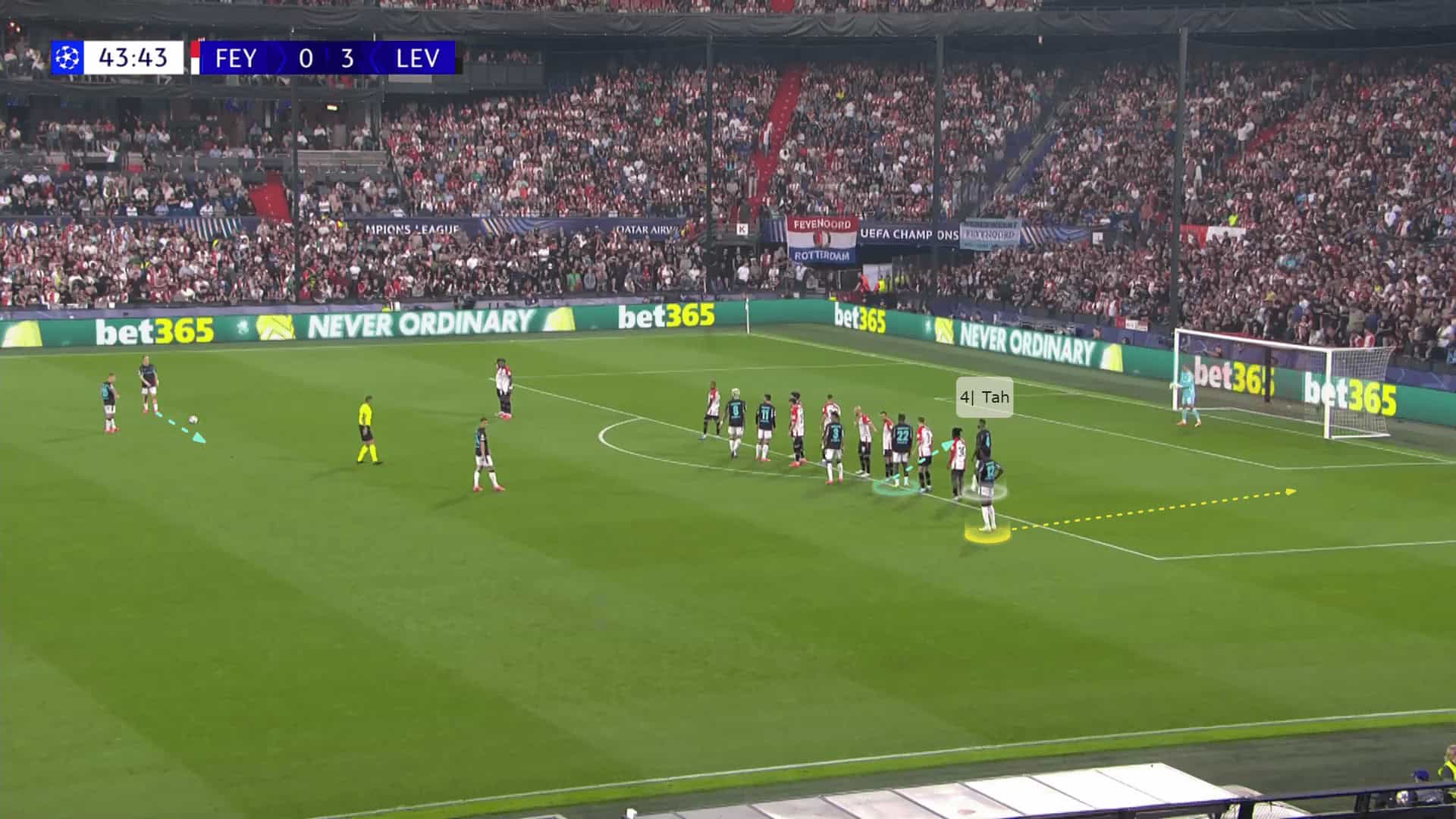Bayer Leverkusen Defensive Struggles
Competition in the Bundesliga looks to be fierce this year.
After five rounds, the defending champions Bayer Leverkusen occupy fourth place with 10 points, just three behind the leaders FC Bayern, who have 13 points; this places them just one point ahead of Eintracht Frankfurt in second place and two points ahead of RB Leipzig, who sit in third.
On the defensive front, the defending champions are not performing optimally; in fact, their performance is quite concerning.
They are among the weakest defensive teams in the Bundesliga, having conceded 10 goals, placing them ahead of only six teams.
It is enough to know that RB Leipzig, in third place, have conceded only two goals.
Conversely, the situation is entirely different on the offensive side.
They possess the second-best attacking line, having scored 14 goals, tied with VfB Stuttgart.
They trail Bayern Munich, who have the strongest attack, having netted 17 goals.
Upon closer examination, it was noted that over 40% of those Leverkusen goals were scored from set-pieces — six goals from such situations, highlighting the impact of set-piece coach Sebastián Parilla.
This makes them the highest-scoring team in the league in this regard, tied with VfB Stuttgart.
However, Leverkusen have a slight edge in expected goals (xG), with 3.9 compared to VfB Stuttgart’s
The significant gap between expected goals (xG) and actual goals highlights their effectiveness in set pieces.
This
tactical analysis will elaborate on this, where we will discuss the key Bayer Leverkusen’s tactics under manager Xabi Alonso and set-piece coach Sebastián Parrilla.Although simple, Parrilla’s set-piece tactics have been highly effective for
Leverkusen.Bayer Leverkusen Corner Kicks Analysis
Starting with corner kicks, Bayer Leverkusen stands out as the best in the league.
They have scored four goals from corners — the highest number in the Bundesliga.
They surpass VfB Stuttgart by a single goal, as Stuttgart have netted three from corners.
Florian Wirtz’s Screens
Bayer Leverkusenhave a unique way of making the best use of Florian Wirtz.
Yes, you heard right, Wirtz at corners!
Although he isn’t good at aerial duels, they exploit that he isn’t usually marked to ask him to block the targeted player’s marker, which is known as a screen—let’s see a showcase.
In the photo below, the opponent defends with five players in the six-yard, three-man markers, a short-option defender, and a rebound defender standing on the edge of the box.
The plan is to target Jonathan Tah in the area beyond the far post, but there are three obstacles:
1- Jonathan Tah’s man marker
2- The last zonal defender who may go to the targeted area
3- The goalkeeper may claim the ball in the air before reaching the targeted area.
After learning about the obstacles, let’s learn how they deal with them.
Wirtz, who pretends to wait on the edge of the box, turns around Tah’s marker, standing behind his back to block him when he tries to step back with Tah.

Now, Wirtz’s screen is shown below. Let’s move on to the other obstacles.
A player (green) stands in front of the goalkeeper, taking his attention to delay his reaction because the goalkeeper tries to push him away.
This is especially true since all of the other attackers move, making deceptive runs, toward the near post, trying to disguise the zonal line.
You can see below that the last zonal defender focuses on what happens on the near post, so his reaction to go to the far post will be late.

The ball reaches Tah excellently while three green players wait on the near post.
If Tah can’t score it directly, he scores a fantastic goal with an amazing header.
Note: the three green players should have fallen a few steps back to avoid offside.

Bayer Leverkusen Targeting The Area Behind The Zonal Line
The second strategy Bayer
Leverkusenuses is targeting the area behind the zonal line on the near post by players who initially stand between the zonal line and the goalkeeper, as shown below.
This trick is so difficult to defend against keeping the zonal line at the same height, and that’s why many elite teams ask the zonal line to take some steps back to reduce the gap between it and the goalkeeper — but what is the difficulty in that?
This positioning is difficult, as attackers positioned behind the zonal line can approach from the blind side of the zonal defenders.
This places the defender in a challenging situation, as they must choose between tracking the ball in the air or turning to locate the attacker.
Additionally, the final conflict for the ball often occurs far from the goalkeeper, making it difficult for him to come out and claim it, especially as congestion begins to form in front of him, which can sometimes impede their movement and distract their attention.
In the photo below, the targeted player (yellow) comes from behind the zonal defender, pushing him forward, and then comes back while the green one blocks the zonal defender beside him to make sure that the targeted area is empty, as shown in the two photos below.


The plan works, and the result is a goal, as shown in the two photos below.


Bayer Leverkusen Short Corners
We can’t talk about Bayer
Leverkusenattacking corners without mentioning that they master short corners, having a unique scheme to make them simple, diverse, effective, and safe from counterattacks.
Starting with their scheme, they position five players inside the box, a very close short-option player and three players forming a triangle, as shown below.
The first step they do is the taker’s overlap after passing the ball to the very close short-option attacker.
This overlap causes a very quick 2-v-1 situation against the short-option defender (orange).
The rebound defender (green) is fixed with the three rebound players, so the first zonal defender needs to cut all this distance to deal with the situation.
Of course, he will be late, giving the taker the opportunity to receive the ball again and cross from a dangerous position.

Inside the box, additional defensive issues arise.
Notably, the defence is often in a state of ascent while the attackers make their runs inward.
This dynamic occurs as the ball is in motion, causing defenders to focus on it and overlook what is happening behind them on the blind side.
Consequently, some markers lose track of their attackers, leading to numerical superiority at the far post (orange), as one marker becomes disengaged while watching the ball.

They make the best use of this strategy by using many ideas, such as changing the direction of play, as in the following case.
In the case below, the opponent has two short-option defenders, which makes it difficult to send a cross, and here, the mission of the triangle at the back comes.
The short-option attacker passes the ball to the right player of the triangle, forcing the rebound defender (green) to press on him, leaving the rebound area empty.
Thus, the triangle can rotate the ball between them easily, reaching the other side.

During that change of the direction of play, the short-option attacker and the taker move to the gap at the new blind side of the defenders, as shown below.

The plan, or the alternative plan, works perfectly.

At the same time, three players are waiting for the pass inside the box, but one player can’t control the ball.

The same strategy applies below, but the first member of the triangle, usually Granit Xhaka, gets closer, dragging the rebound defender, leaving this area empty for Wirtz to shoot.

Xhaka turns around to pass the ball to Wirtz, who can shoot easily, as shown in the two photos below.


Bayer Leverkusen Free Kicks Analysis
At free kicks, Leverkusen have a common strategy using two-taker manipulation.
This requires the first taker to step over the ball while an attacker (green) moves forward at the same time to persuade the defender that the ball will be played, making that defender move with him, covering the offside trap.
This is clear in the case below against Feyenoord in the UEFA Champions League.
The other part of the plan is asking Tah to start in an off-side position to stand in the last defender of the line’s way when he decides to drop to follow the real targeted player who starts late (yellow) and then takes off with Tah’s block to the last zonal defender of the line.

The key moment of stepping over the ball is shown below.
You can notice the green-highlighted attacker dragging the defender, covering the offside.

The plan works while the rest of the players wait for the headed pass, which is done, but the ball hits the goalkeeper and turns into their own goal.

Conclusion
In this analysis, we discussed the key characteristics distinguishing Bayer Leverkusen’s set-piece contributions from assistant coach Sebastián Parilla in 2024/25, including corner kicks and free-kicks.
Bayer
Leverkuseneffectively implements straightforward yet highly effective tactical strategies and routines, which could be a decisive factor in the 2024/2025 Bundesliga season, where competition is expected to be intense.
Despite Florian Wirtz’s lack of distinction in aerial duels, this set-piece analysis showed how Bayer Leverkusen effectively utilises Wirtz during corner kicks.
We highlighted their strategy of targeting the space behind the zonal line and their adept use of short corners.
Finally, we explained the most essential and frequently implemented idea in their free-kick executions.
Only time will tell if Xabi Alonso’s tactics will be enough for Bayer
Leverkusen to defend their Bundesliga title for another year.





Comments